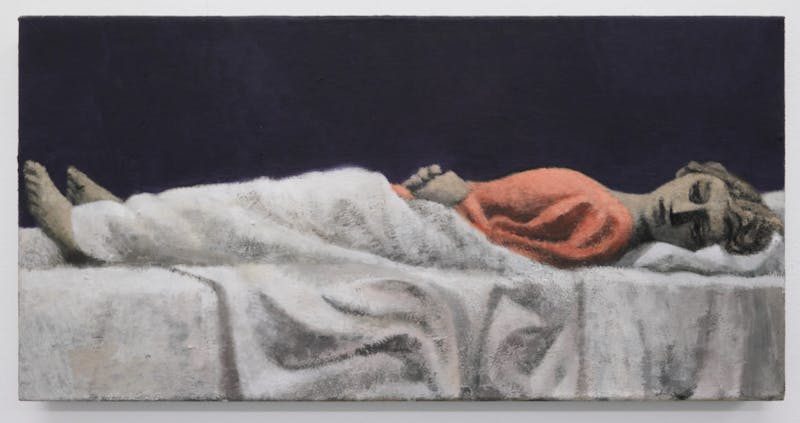Lenz Geerk spent his spring wrestling with insomnia. Endless fretful nights yanking at bed sheets, and sighing in fidgety despair while the early sun peered through the curtains. Unable to comprehend why it was happening to him, by day he went to his studio to burrow, soaking up the silence. Geerk had to strenuously keep himself awake, jittering through cups of coffee, listening to audiobooks of Bronte and Cixin Liu, trying to shake his night's torment from the forefront of his mind.
Working on one painting at a time, hung against a messy white wall that looked as if it had been continually pelted with paintball fire, his characters – plucked from his meandering dreams – emerge from landscapes of forests, deserted mountains and hillsides which, as more paint is applied become less and less visible. Masked over in flat colour, Geerk leaves only traces of background detail. The technique exposes his protagonists in reverie as they stand keeled over or lying languidly under crumpled bed sheets.

Lenz Geerk, Hotel, 2019
Geerk paints in acrylics which dry to a matte glaze, applying a mass of colour before the scene unfolds. The surface dries quickly creating a weighty blanket over the canvas. He then works into the canvas – speckling blacks and greys to highlight contortions, using the brush like a graphite stick to paper.
For Lenz Geerk, sleep is a desired escape from the complexities of the world. His inability to sleep leaves him yearning a withdrawal that is denied him, and he becomes a spectator or voyeur, always on. While he sits on his camping chair with paint-muddied trousers, barely able to keep his eyes open, his characters synchronise with his lethargy: the bed is his symbol of sanctuary, a place to retreat from the noise. By painting he aims to control his anxieties, allowing a chosen hinterland to emerge. Equally, by committing his sleeplessness to canvas, the anguishes of insomnia are materialised; each indecision, wavering thought or gesture becomes not just conspicuous but perpetual – permanent.
Geerk’s studio is in the suburbs of Dusseldorf in an industrial studio complex. Liberated from distractions, it is like a bunker – devoid of media, divorced from the outside world. But it is no sanctuary. Paintings lay stacked across the floor and on those paint-spattered walls, while a series of white figurative clay sculptures dry on a radiator. As Geerk’s paintings sleep – he pours himself another cup of coffee…